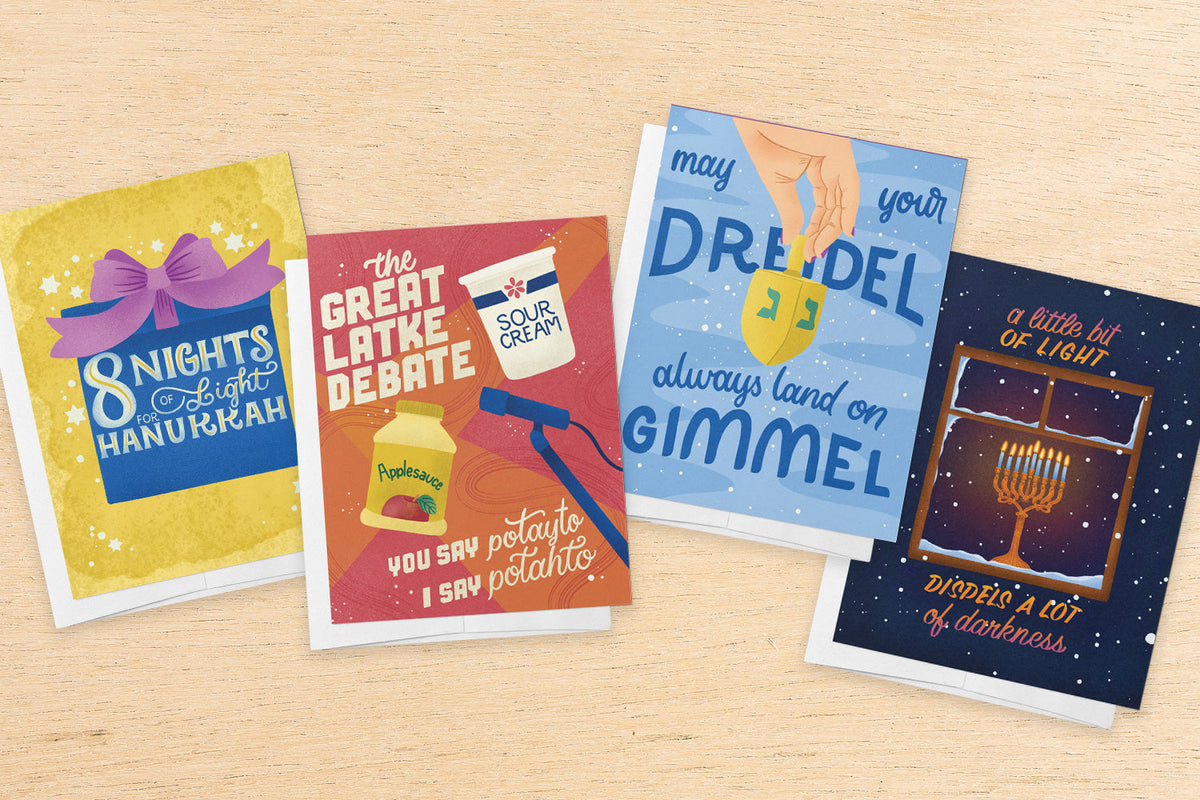
Anatomy of a Hanukkah Card
|
|
Time to read 2 min
|
|
Time to read 2 min
Hanukkah is a relatively minor holiday in the Jewish calendar, but because of its proximity to Christmas it has become increasingly visible in American culture. In an effort to be inclusive (or perhaps to tap the Jewish market), many companies produce Hanukkah products in the same way they would Christmas products. Plus, so many people want to share their seasonal joy with their friends and neighbors, though they recognize that sending a Christmas card might not be the best fit.
It's pretty amazing that there are options available in mainstream shops! However, some Hanukkah cards miss the mark because they were designed by somebody who isn't Jewish. Many companies assume the same sentiments and ideas that go into Christmas cards will translate into another demographic. They're both winter holidays, after all! And yet, some of the things that somebody who isn't Jewish might think of as being generically seasonal would strike a Jewish person as being decidedly Christmas oriented. This happens all the time, unfortunately. Have you seen grocery stores displaying "Hanukkah ham?" Here's how you can ensure your Hanukkah cards don't miss the mark.
So, there are no hard and fast rules about what SHOULD be in a Hanukkah card. But there are definitely some elements that do not belong. It's easier to explain what shouldn't be in your Hanukkah greeting!
1. Mixed up holidays: not all ritual items or foods are used for every holiday. While you might recognize matzah as a Jewish food, it's 100% not a Hanukkah food. Don't include other holiday's symbols in a Hanukkah card!
2. Other cultural symbols: lots of things you may associate with general winter holiday have nothing to do with Hanukkah. Narcissus? A beautiful flower you might associate with winter and maybe not explicitly Christmas. But not a symbol of Hanukkah, and not relevant in a Hanukkah card.
3. Stereotypes: Years ago, I saw a major retailer selling a photo booth prop that was a black hat with peyot attached (an Orthodox man's curly side locks). It probably goes without saying that this is offensive! You'd be surprised at the number of inappropriate stereotypes. Or maybe you wouldn't be.
An effective greeting card is one that you can relate to or see some element of yourself reflected back. Purchasing Jewish art directly from a Jewish artist means that your Hanukkah card will ring true and feel authentic. This Hanukkah card is my best selling item, and I think it's because people relate to it. They can see their lived experience in the art, both in the darkness and in the light.
Hanukkah cards designed by people who aren't Jewish often rely on misconceptions or stereotypes. Or, at the very least, reflect a shallow understanding of the culture. This is true of any art and any culture; if you aren't a member of that culture, odds are that you won't be able to meaningfully or accurately portray it to other people. So, what's the best way to honor Jewish cultural significance? By supporting Jewish artists, who share their lived experience in their work.
Marketing Hanukkah cards and other items designed by people who aren't Jewish takes away our voice and our ability to define and reflect our on culture. There are so many ways we understand and define our own cultures; there's no need to speak over someone's authentic voice.
Here are some common greetings you can include in your Hanukkah card:
But most importantly, your Hanukkah card comes from YOU, so share your joy!
